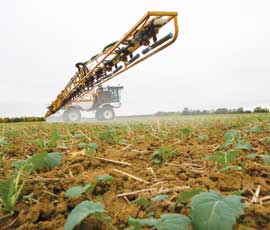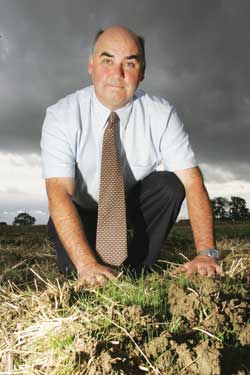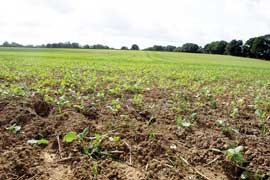Growers urged to make the most of OSR herbicides

Without the help of carbetamide, propyzamide and metazachlor, blackgrass control in oilseed rape would be very difficult to achieve, says James Clarke of ADAS (pictured below).
“They’re vital,” he says. “Blackgrass is present on about 40% of the current rape area and if it isn’t controlled will cause in the region of a 36% yield loss.”
That means output could be reduced by up to 1.2t/ha if these key active ingredients were withdrawn or banned, he warns. “Growers would really struggle if they weren’t around. Gross margins would fall by up to £390/ha and the rotational implications would be even greater.”
The wheat crop would have to shoulder additional costs, while growers would be forced to look for alternative break crops and make greater use of techniques such as ploughing in order to bury weed seeds.
However, cultural control methods, such as the use of ploughing, delayed drilling and higher seed rates, are far harder to use in oilseed rape than they are in cereal crops, says Stephen Moss of Rothamsted Research.
“It’s even more important to get the most from herbicides in oilseed rape, because we don’t have the same alternative control opportunities,” he explains. “The crop is in the ground for 10 out of 12 months.”
 Ploughing reduces the efficacy of the key residual herbicides, while a move has taken place recently to lower seed rates rather than higher, in order to manage plant populations and canopy structure, he says.
Ploughing reduces the efficacy of the key residual herbicides, while a move has taken place recently to lower seed rates rather than higher, in order to manage plant populations and canopy structure, he says.
“Delayed drilling also isn’t applicable. The oilseed rape crop has to be in the ground in good time so it develops sufficiently to survive the winter.”
This means herbicides are a vital part of the armoury. “Against this background, there has been a loss of efficacy in a number of herbicides due to the development of resistance. So oilseed rape really needs to regain its place as a cleaning crop.”
The good news is that neither carbetamide nor propyzamide have been found to be affected by resistance, says Dr Moss. “There’s no evidence any resistance mechanisms exist to these products.”
That gives them a clear advantage over some of the other herbicides used in oilseed rape, particularly the more specific graminicides used on blackgrass populations with target-site resistance, he says.
“Trial work has shown carbetamide is equally effective on a range of blackgrass populations. It can be used regardless of the resistance status of blackgrass, without compromising the results.”
However, carbetamide is one of the pesticides listed as having an effect in Drinking Water Protected Areas and its use is under scrutiny, says Jo Kennedy of the Environment Agency.
“It’s not the only one. The biggest offender is metaldehyde, but others include propyzamide, chlorotoluron, mecoprop and MCPA.”
Understanding why carbetamide is found in water is essential if solutions are to be found, she believes.
“We know it is used during late autumn and winter, which is when we see peaks of carbetamide in water supplies, and that it’s important as part of a blackgrass control strategy. We also know drain flow and run-off are the two main pathways by which it gets into water.”
Measures for preventing herbicides reaching water are only effective if there are high levels of adoption by growers in the relevant catchments, she stresses. “We need good uptake of the right practice.”
| Environment Agency website update |
|---|
| Finding out whether you are farming in a Drinking Water Protected Area or a Safeguard Zone can now be done on the Environment Agency website. A postcode searchable tool on the What’s In Your Back Yard (WIYBY) pages allows farmers identify areas and zones at risk from pesticides, says Ms Kennedy, with further details available when the highlighted area is clicked on. “It’s a new development on our website and it will help to clarify the areas at risk.” |
As far as run-off is concerned, safe areas for storing, handling and mixing herbicides are needed in the farm yard, while buffers are required in the field, she says.
“Reducing drain flow is more tricky. Switching to alternative products, such as propyzamide, is just pollution swapping, while growing a different crop can have implications for farm profitability.”
More research is needed into measures which can smooth out peaks, such as retention ponds and wetlands, believes Ms Kennedy, and changing application timing and the rate applied could be beneficial.
“The other factor is that we need to understand the future risks,” she says. “If the area of oilseed rape being grown continues to rise, will that result in an increase in blackgrass, for example? And if so, will herbicide use go up?”
Finding a solution also means meeting government policy objectives on drinking water protection and sustainable food and farming, she says. “There are two areas of policy to consider.”
Changing carbetamide use
 Bringing Crawler (carbetamide) into the weed control programme earlier in the season would allow its use at lower rates before soils are saturated and target it at shallow-rooted blackgrass, says Stuart Hill of Makhteshim Agan UK.
Bringing Crawler (carbetamide) into the weed control programme earlier in the season would allow its use at lower rates before soils are saturated and target it at shallow-rooted blackgrass, says Stuart Hill of Makhteshim Agan UK.
Not only would this reduce the effect of rainfall events and the possibility of leaching, it should also improve blackgrass control by up to 20% and replace the need for a specific graminicide.
“It doesn’t involve an additional pass, as growers would be using the existing mid-September/early October timing, when they have traditionally had to apply Aramo as an interim measure,” he explains.
“But it does require a different mindset. It challenges traditional practices.”
By bringing the carbetamide application forward, it would act as a holding spray on the blackgrass, sensitising it to the traditional propyzamide application in November, he says. Unlike Aramo (tepraloxydim), there’s no resistance to carbetamide, making it resistance neutral.
At this timing, Crawler can be used at a 2.5kg/ha rate, which is a 30% reduction. “We’re not aiming for maximum persistence from this approach, rather getting the product to last for two to three weeks and to put an immediate hold on blackgrass.
“It is part of a sequence,” he says. “You will still need to follow up with propyzamide.”
From a practical point of view, crop canopies are more open at the earlier timing, according to Mr Hill. “Residuals need to be applied to the soil, not the leaf, so application is easier and more likely to be successful. What’s more, the blackgrass is smaller, with shallow roots, so it is more vulnerable to the herbicide.”
In addition, carbetamide has more mobility in the soil than propyzamide, so will work better than its stablemate from an earlier application, he says. “But the crop must be at the three- to four-leaf stage before treatment, to avoid any damage.”
Crop establishment systems which result in blackgrass germinating from a range of depths can cause difficulties with grassweed control from residuals, he acknowledges.
“Both carbetamide and propyzamide work best when there is minimal soil disturbance and sufficient soil moisture. If sub casting is being used, the earlier application of Crawler will help to hit the blackgrass when it is smaller, rather than leaving it to be well-tillered with a significant root system by November.”
Mr Hill points out that the new Crawler timing tackles two very pressing issues – blackgrass and the Water Framework Directive.
“We are challenging tradition and making growers rethink blackgrass control in oilseed rape. Earlier programmes at lower doses seem to be the way forward.”

